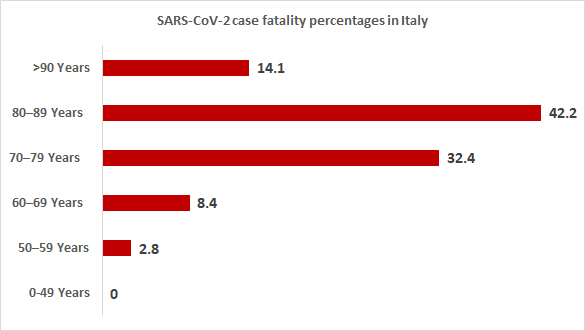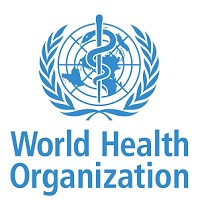World maps of the SARS-CoV-2 cases
What is SARS-CoV-2 (COVID-19, Wuhan coronavirus, 2019-nCoV)?
Are there other types of coronaviruses?
What are the symptoms of COVID-19?
These symptoms are usually mild. Some people become infected but do not develop any symptoms and do not feel unwell.

Most people (about 80%) recover from the disease without any treatment.

Around 1 in 6 people develop a severe disease which is characterized by breathing difficulties.

Older people (> 70 years), those with underlying medical problems and chronic diseases are more likely to develop serious illness.
Does the virus lead to death and very severe infections in all cases?
80% of the cases are mild to moderate, 15% are severe and 5% are critical cases.
Although the overall case fatality is predicted to be around (3-4)% worldwide, deaths are clustered mainly in aged people and immunocompromised patients (Fig.1). Italy, however, has a higher case fatality rate (6.6%) (Fig.2).



How could one get infected?
Person-to-person through small droplets released from the nose or mouth during coughing, sneezing or exhaling.
Touching contaminated surfaces that contain droplets from infected patients then touching the face without washing hands.
To avoid infection stay more than 1.5 meter away from a sick person.
What is the difference between the SARS-CoV-2 and influenza viruses?
Both have a similar disease presentation which ranges from asymptomatic or mild through to severe disease and death.
Both viruses are transmitted by contact, droplets and fomites.
Disease transmission in influenza virus is faster than SARS-CoV-2.
SARS-CoV-2 seriously affects the elderly especially those with underlying health conditions while influenza also induces serious disease in children, pregnant women. The number of patients who suffer from severe and critical disease is higher with SARS-CoV-2 than with influenza virus infection.
Case fatality of SARS-CoV-2 is currently 3-4%, while for influenza it is below 0.1%.
How long does the virus live in the environment?
Generally, coronaviruses may stay viable for hours to days. This may vary based on the environmental temperature, humidity and presence of organic material around the virus.
Is hand wash or alcohol hand rub enough to inactivate the virus?
Yes, alcohol-based hand rub and/or soap and water is enough.
Can the disease be transmitted from food?
The virus has been isolated stool. It is important to clean hands regularly after using the bathroom and before eating.
Should I wear a mask?
WHO recommends the use of masks for people who have symptoms of SARS-CoV-2 (COVID-19) and for health workers and people who are taking care of someone (at home or in a healthcare facility).
Is there general advice for virus prevention other than using masks?
Avoid contact with sick people and maintain social distancing of 2m. Strengthen your immunity by eating healthy foods rich in vitamins, especially those rich in vitamin C.
Is there any impact of SARS-CoV-2 on pregnant women?
According to the College of American Pathologists (CAP), so far, pregnancy do not seem to be a risk factor that would contribute to maternal-fetal viral transmission or to greater baby or maternal deaths among pregnant women with COVID-19.
Is there any vaccine or treatment for the virus?
There is no current vaccine but there are many vaccines in progress. However, it may be many months before these are available.
Sera/plasma from COVID-19 recovered patients (containing specific antibodies against the virus) can be used for treatment of infected people.
Although there is no effective globally approved treatment against coronavirus the FDA approved drugs chloroquine, hydroxy chloroquine and Favipravir were found to be effective against the virus.
Is there any restriction for people who recovered from COVID-19 when donating blood?
According to the FDA, blood establishments may wish to consider retrieval and quarantine of blood and blood components collected in the 28 days prior to or after COVID-19 disease onset; or collected in the 28 days prior to or after possible exposure to patients with COVID-19 infection.
Can pet animals be infected?
Pet animals can be infected with SARS-CoV-2, However, there is no evidence to date that the virus is being transmitted from pets to humans.
So far, there are only three known cases (2 dogs in Hong Kong and 1 cat in Belgium) where the pet has been infected by humans. Pets are advised to be quarantined if their owners are positive to SARS-CoV-2 (COVID-19).

Professional details
Nomenclature
The WHO declared that the disease is called coronavirus disease (COVID-19) is caused by SARS-CoV-2 virus.
SARS-CoV-2 | ICTV | NCBI Taxonomy
HCoV-19 | Wuhan Virologists
Virus origin, reservoir and animal infections
First sequence of the virus
Proximal origin of the virus
Review articles: Review 1
Bats| Bat origin of the SARS-CoV-2
Pangolin as a possible animal host of SARS-CoV-2 Paper 1 | Paper 2 | Paper 3 | Paper 4 | Paper 5 [closely related virus from pangolin] | Paper 6
Pet animals
There is no evidence to date that the virus is being transmitted from pets to humans.
Dogs | Two dogs tested positive to SARS-CoV-2 in Hong Kong after close exposure to their infected owner | First case | Second case
The dogs showed no disease symptoms and the cat had transient respiratory and digestive disorders.
Cats | A cat was infected with SARS-CoV-2 in Belgium from its owner. The cat had transient respiratory and digestive clinical signs.
SARS-CoV2 virus was detected in the feces and vomit of a cat with digestive and respiratory symptoms. The presence of SARS-
CoV-2 virus was confirmed by PCR (high throughput sequencing).
Tigers and lions | SARS-CoV-2 was detected only from a single tiger showed signs of respiratory distress after being exposed to a SARS-CoV-2 infected zoo employee who was actively shedding virus in New York. However many tigers and lions exhibiting similar respiratory symptoms [Samples of big cats requires general anesthesia].
Minks|On 26 April, two mink farms in the province of Brabant had contracted the disease COVID-19
Experimental infection
Ferret, dogs and cats| Experimental infection of SARS-CoV-2 revealed that ferrets and cats are highly susceptible while dogs have low
susceptibility. Pigs, chickens, and ducks are not susceptible to the experimental infection virus
Receptor binding and spike
- Crystructure of the spike
- SARS-CoV-2 Cell Entry Depends on ACE2 and TMPRSS2
- Structural analysis of the receptor binding
- High expression of ACE2 in oral mucosa
- Screening of possible intermediate hosts based on the relatedness of ACE2
- SARS-CoV-2 entry, syncytia formation and cross-neutralization with SARS-CoV infected patients.
- Potent pan-coronavirus fusion inhibitor targeting its spike protein
- Structural basis of receptor recognition by SARS-CoV-2
Variants of interst and genomic alteration of the virus
Sensitive antivirals
Sensitive antivirals
Coronavirus puts drug repurposing on the fast track
Remdesivir and chloroquine
High in vitro sensitivity to Remdesivir and chloroquine | Clinical trial of Chloroquine phosphate | Clinical trial 2
Favipiravir [inhibitor of viral RNA polymerase]
Potent pan-coronavirus fusion inhibitor targeting its spike protein
Favipiravir was approved in China
Possible sensitive antivirals
Ivermectin
Clinical antiviral experience form Chinese experience
Although there is no clinical evidence for effective antiviral drugs, some drugs have been trialed. This is an example from a single center in China.
Basic regimen: lopinavir/ritonavir (2 capsules, po q12h} combined with arbidol (200 mg poql 2h).
The average time to achieve a negative viral nucleic acid test was 12 days (95% Cl: 8-15 days).
The duration of the negative nucleic acid test result was 13.5 days.
Alternative regimen: If the basic regimen was not effective, chloroquine phosphate was used in adults between 18-65 years old :500 mg bid for first two days, 500 mg qd for following five days).
The treatment course of chloroquine phosphate should be no more than 7 days.See also potential options from Korean experience












